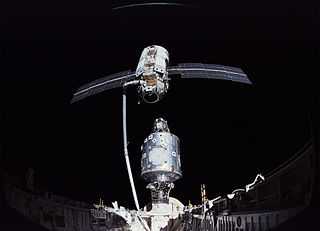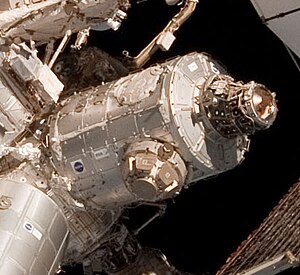
The International Space Station (ISS) is the largest modular space station in low Earth orbit. The project involves five space agencies: the United States' NASA, Russia's Roscosmos, Japan's JAXA, Europe's ESA, and Canada's CSA. The ownership and use of the space station is established by intergovernmental treaties and agreements. The station serves as a microgravity and space environment research laboratory in which scientific research is conducted in astrobiology, astronomy, meteorology, physics, and other fields. The ISS is suited for testing the spacecraft systems and equipment required for possible future long-duration missions to the Moon and Mars.

Columbus is a science laboratory that is part of the International Space Station (ISS) and is the largest single contribution to the ISS made by the European Space Agency (ESA).

STS-88 was the first Space Shuttle mission to the International Space Station (ISS). It was flown by Space Shuttle Endeavour, and took the first American module, the Unity node, to the station.

STS-98 was a 2001 Space Shuttle mission to the International Space Station (ISS) flown by Space Shuttle Atlantis. It was the first human spaceflight launch of the 21st century. STS-98 delivered to the station the Destiny Laboratory Module. All mission objectives were completed and the shuttle reentered and landed safely at Edwards Air Force Base on 20 February 2001, after twelve days in space, six of which were spent docked to the ISS.

A Multi-Purpose Logistics Module (MPLM) is a large pressurized container that was used on Space Shuttle missions to transfer cargo to and from the International Space Station (ISS). Two MPLMs made a dozen trips in the Shuttle cargo bay and initially berthed to the Unity module and later the Harmony module on the ISS. From there, supplies were offloaded, and finished experiments and waste were reloaded. The MPLM was then reberthed in the Shuttle for return to Earth. Three modules were built by the Italian Space Agency (ASI): Leonardo, Raffaello, and Donatello.

The Cupola is an ESA-built observatory module of the International Space Station (ISS). Its name derives from the Italian word cupola, which means "dome". Its seven windows are used to conduct experiments, dockings and observations of Earth. It was launched aboard Space Shuttle Endeavour's mission STS-130 on 8 February 2010, and attached to the Tranquility module. With the Cupola attached, ISS assembly reached 85 percent completion. The Cupola's central window has a diameter of 80 cm (31 in).

The Unity connecting module, also known as Node 1, is the first U.S.-built component of the International Space Station (ISS). It connects the Russian and United States segments of the station, and is where crew eat meals together.

The Destiny module, also known as the U.S. Lab, is the primary operating facility for U.S. research payloads aboard the International Space Station (ISS). It was berthed to the Unity module and activated over a period of five days in February, 2001. Destiny is NASA's first permanent operating orbital research station since Skylab was vacated in February 1974.

Harmony, also known as Node 2, is the "utility hub" of the International Space Station. It connects the laboratory modules of the United States, Europe and Japan, as well as providing electrical power and electronic data. Sleeping cabins for four of the crew are housed here.

STS-130 was a NASA Space Shuttle mission to the International Space Station (ISS). Space ShuttleEndeavour's primary payloads were the Tranquility module and the Cupola, a robotic control station with six windows around its sides and another in the center, providing a 360-degree view around the station. Endeavour launched at 04:14 EST on February 8, 2010 and landed at 22:22 EST on February 21, 2010, on runway 15 at the Kennedy Space Center's Shuttle Landing Facility.

The Pressurized Mating Adapter (PMA) is a class of spacecraft adapters that convert the Common Berthing Mechanism (CBM) used on the US Orbital Segment to APAS-95 docking ports. There are three PMAs located on the International Space Station (ISS); the first two were launched with the Unity connecting module in 1998 aboard STS-88, and the third was launched in 2000 aboard STS-92. All three of the PMAs are now used to permanently connect parts of the ISS, so they are no longer available as docking ports for visiting spacecraft.

The process of assembling the International Space Station (ISS) has been under way since the 1990s. Zarya, the first ISS module, was launched by a Proton rocket on 20 November 1998. The STS-88 Space Shuttle mission followed two weeks after Zarya was launched, bringing Unity, the first of three node modules, and connecting it to Zarya. This bare 2-module core of the ISS remained uncrewed for the next one and a half years, until in July 2000 the Russian module Zvezda was launched by a Proton rocket, allowing a maximum crew of three astronauts or cosmonauts to be on the ISS permanently.

Kounotori 2, also known as HTV-2, was launched in January 2011 and was the second flight of the Japanese H-II Transfer Vehicle to resupply the International Space Station (ISS). It was launched by the H-IIB Launch Vehicle No. 2 manufactured by Mitsubishi Heavy Industries (MHI) and JAXA. After the supplies were unloaded, Kounotori 2 was loaded with waste material from ISS, including used experiment equipment and used clothes. Kounotori 2 was then unberthed and separated from the ISS and burned up upon reentering the atmosphere on 30 March 2011.

The Leonardo Permanent Multipurpose Module (PMM) is a module of the International Space Station. It was flown into space aboard the Space Shuttle Discovery on STS-133 on 24 February 2011 and installed on 1 March. Leonardo is primarily used for storage of spares, supplies and waste on the ISS, which was until then stored in many different places within the space station. It is also the personal hygiene area for the astronauts who live in the US Orbital Segment. The Leonardo PMM was a Multi-Purpose Logistics Module (MPLM) before 2011, then was modified into its current configuration. It was formerly one of two MPLM used for bringing cargo to and from the ISS with the Space Shuttle. The module was named for Italian polymath Leonardo da Vinci.

The US Orbital Segment (USOS) is the name given to the components of the International Space Station (ISS) constructed and operated by the United States National Aeronautics and Space Administration (NASA), European Space Agency (ESA), Canadian Space Agency (CSA) and Japan Aerospace Exploration Agency (JAXA). The segment consists of eleven pressurized components and various external elements, all of which were delivered by the Space Shuttle.

Docking and berthing of spacecraft is the joining of two space vehicles. This connection can be temporary, or partially permanent such as for space station modules.

The European contribution to the International Space Station comes from 10 members of the European Space Agency (ESA) and amounts to an 8% share in the programme. It consists of a number of modules in the US Orbital Segment, ATV supply ships, launchers, software and €8 billion.

The Nanoracks Bishop Airlock is a commercially-funded airlock module launched to the International Space Station on SpaceX CRS-21 on 6 December 2020. It was berthed to the Tranquility module on 19 December 2020 by the Canadarm2. The module was built by Nanoracks, Thales Alenia Space, and Boeing. It is used to deploy CubeSats, small satellites, and other external payloads for NASA, Center for the Advancement of Science in Space (CASIS), and other commercial and governmental customers. NASA plans on using the airlock as a brand new way to dispose large pieces of trash. The name refers to the bishop chess piece, which moves diagonally.

Axiom Orbital Segment or Axiom Segment are the planned modular components of the International Space Station (ISS) designed by Axiom Space for commercial space activities. Axiom Space gained initial NASA approval for the venture in January 2020. Axiom Space was later awarded the contract by NASA on February 28, 2020. This orbital station will be separated from the ISS to become a modular space station, Axiom Station, after the ISS is decommissioned.

The International Habitation Module, International Habitat or I-HAB is designed as the main habitat module of the Lunar Gateway station, to be built by the European Space Agency (ESA) in collaboration with the Japan Aerospace Exploration Agency, or JAXA. The addition of the I-HAB and the Habitation and Logistics Outpost (HALO) module will provide a combined 125 m3 (4,400 cu ft) of habitable volume to the station.






























